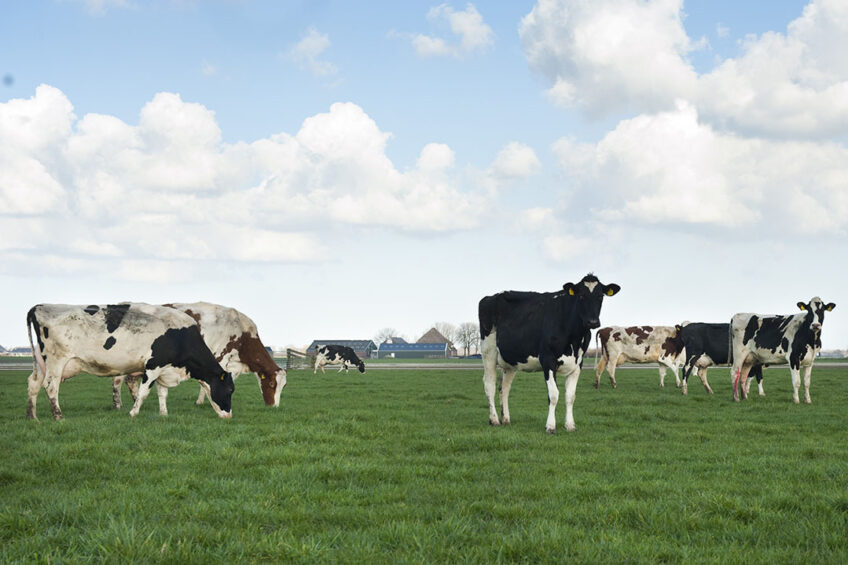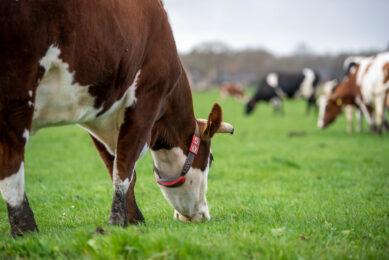Urease inhibitor: Reduce ammonia in the barn and on pasture

In recent studies (2021) published in Biosystems Engineering, and Environmental Technology, 2 urease inhibitors are used to reduce ammonia emissions in a mechanically ventilated dairy housing system and on pasture.
Ammonia gas mainly originates from the microbial conversion of urea in urine through hydrolysis. The hydrolysis process could be reduced by inhibiting the urease enzyme. Urease inhibitors may act as a suitable mitigation measure without requiring the high investment costs usually connected to barn redesigning.
Study setup
Their study mainly aimed at a) quantifying the reduction potential of the urease inhibitor K (a phosphorodiamidate) by direct ammonia concentration measurements in a mechanically ventilated dairy barn and b) measuring the reduction response of the inhibitor over time. To verify the inhibitor effect on the urease, urease activity was measured. The approach also aimed at distinguishing seasonal (summer, winter, and spring) differences on ammonia reduction.
The setup consisted of 2 units, each housing 16 lactating Holstein-Friesian cows with comparable daily milk yields, average milk urea concentrations, age, and parity. The ventilation rate inside the units was set at a fixed capacity of around 11000 m3/h during spring and around 17000 m3/h during summer and winter. Exhaust air from each ventilator and background air from 2 sampling points outside the units was sampled constantly.

Application technique
The researchers used an automatic backpack sprayer (placed on a commercial rollator) to apply the inhibitor on top of the slatted floor. 2 anti-drift nozzles were mounted onto a spray bar in the front. Their target was to apply 2.5 mg of the urease inhibitor in 50 ml of water per m2.
Urease activity
The inhibitor was applied to a concrete surface that was previously fouled with cattle manure. A urease activity reduction of 149% (winter), 90% (spring) and 92% (summer) was observed for both units. The high reduction value in winter was attributed to large number of negative values, therefore, we need to interpret this reduction with caution. In summary, a clear decrease in urease activity after inhibitor application is detected.
Seasonal ammonia emission reductions
The highest reduction potential was found in the winter measurement and the lowest in the summer measurement. Ammonia emissions were reduced by 17–23% in summer, 10–31% in winter and 22% in spring. The researchers mentioned that during winter, emissions are already at a lower level and during the summer, multiple sources contribute to higher emission levels (these factors were not elaborated though). They found highest reductions between the 12-h and 16-h time slots following the application of the inhibitor. They also observed a residual effect of the inhibitor at the 24-h time slot. “These observations will be valuable for further investigations relating to the frequency of inhibitor application,” they concluded.
Figure 1 – The automatic backpack sprayer on a rollator.

Urease inhibitor on pasture
Urine deposition by grazing livestock is the single largest source of ammonia emissions on pasture systems. Most studies have measured the effect of urease inhibitors on ammonia emission reduction from urine by applying urine mixed with the inhibitor to the pasture soil to increase the chances of better interaction of urine and the inhibitor. However, these trials do not represent a realistic grazing scenario where only urine is deposited onto the soil.
This second study aimed at identifying the best time to spray a urease inhibitor nBTPT (a urease inhibitor containing 0.025% N-(nbutyl) thiophosphoric triamide) onto pasture soil to reduce ammonia losses from urine patches. The pasture was a mixture of ryegrass and white clover.
The treatments were as follows:
• Control (without urine and nBTPT),
• Urine alone at 530 kg N per hectare
• Urine plus nBTPT.
The urease inhibitor was applied to soil plots 5 and 3 days (UAgr-5 and UAgr-3, respectively) prior to urine deposition, on the same day (UAgr0), and 1, 3 and 5 days (UAgr1, UAgr3 and UAgr5, respectively) after urine deposition, in autumn. Ammonia losses were measured using the dynamic chamber method. When nBTPT and urine were applied on the same day (UAgr0), the grass was cut to mimic grazing, urine was applied and then the inhibitor was sprayed.
Figure 2 – Cumulative ammonia emissions following urine deposition before, on the same day, and after nBTPT application.

Reducing ammonia emissions from urine patches
The application of the inhibitor 5 days and 3 days prior to urine deposition reduced NH3 emission by 27.6% and 17.5%, respectively. When the inhibitor was applied on the same day (UAgr0) as urine, the NH3 emission was reduced by 9.6%. On the other hand, reductions in NH3 emission for inhibitor applied post urine deposition was not significant; the reduction was in the range 0.6–2.9%.
The significant reductions achieved in UAgr-5 and UAgr-3 indicated that the inhibitor effectively inhibited the activity of the urease before urine application in comparison with urine alone. “A possible reason for the difference between applied nBTPT before and on the same day or days (1, 3 and 5) after urine application may be that nBTPT applied 5 and 3 days prior to grazing inhibited the urease activity in the plant and soil before urine application,” they said. According to their results, the urea hydrolysis took place during the first 24 hours. It was remarked that although the method used here has practical limitations, it is more realistic than that employed in other studies where nBTPT was mixed with urine before application.
Finding ways to reduce ammonia emissions on dairy farms
Livestock-heavy countries around the world are under pressure to reduce their ammonia emissions. We look at methods that can reduce these emissions. Find out more…
Conclusion
Urease inhibitors have the potential to reduce ammonia emissions. For a more effective application procedure, a fully automatic system is preferable, for example, a robot could carry a tank with the inhibitor solution. However, the use of already existing farm equipment for application could reduce extra investment costs. There is a large potential cost-saving if treatments can be targeted directly to urine patches, thereby avoiding the need to spread inhibitors. Previous studies have shown that using survey-grade global positioning system (GPS) technology can precisely measure the paddock spatial area coverage, diversity, and distribution of urine patches in grazed paddocks over time.
More info on the recent studies in Biosystems Engineering and Environmental Technology.
Join 13,000+ subscribers
Subscribe to our newsletter to stay updated about all the need-to-know content in the dairy sector, two times a week.










